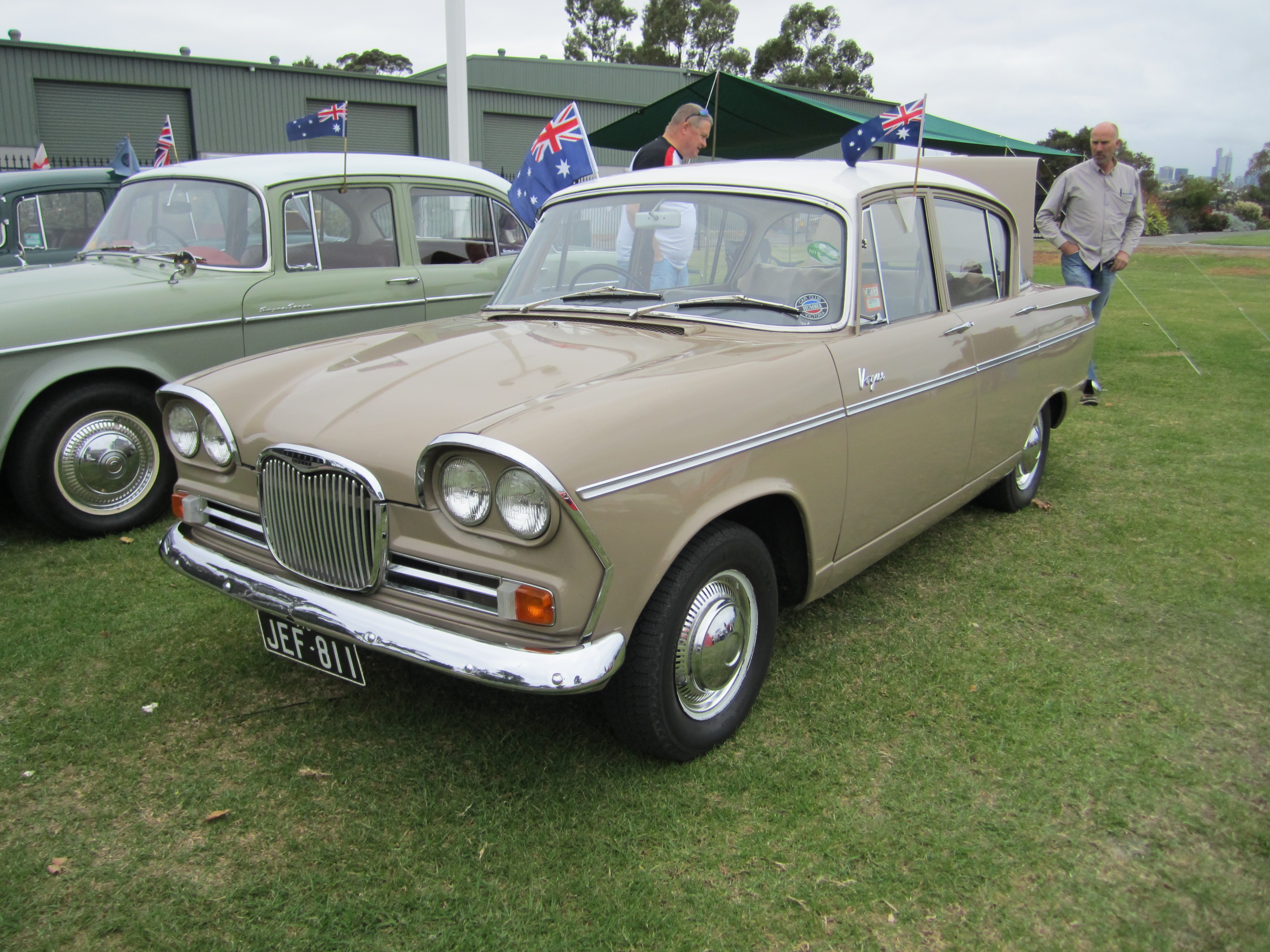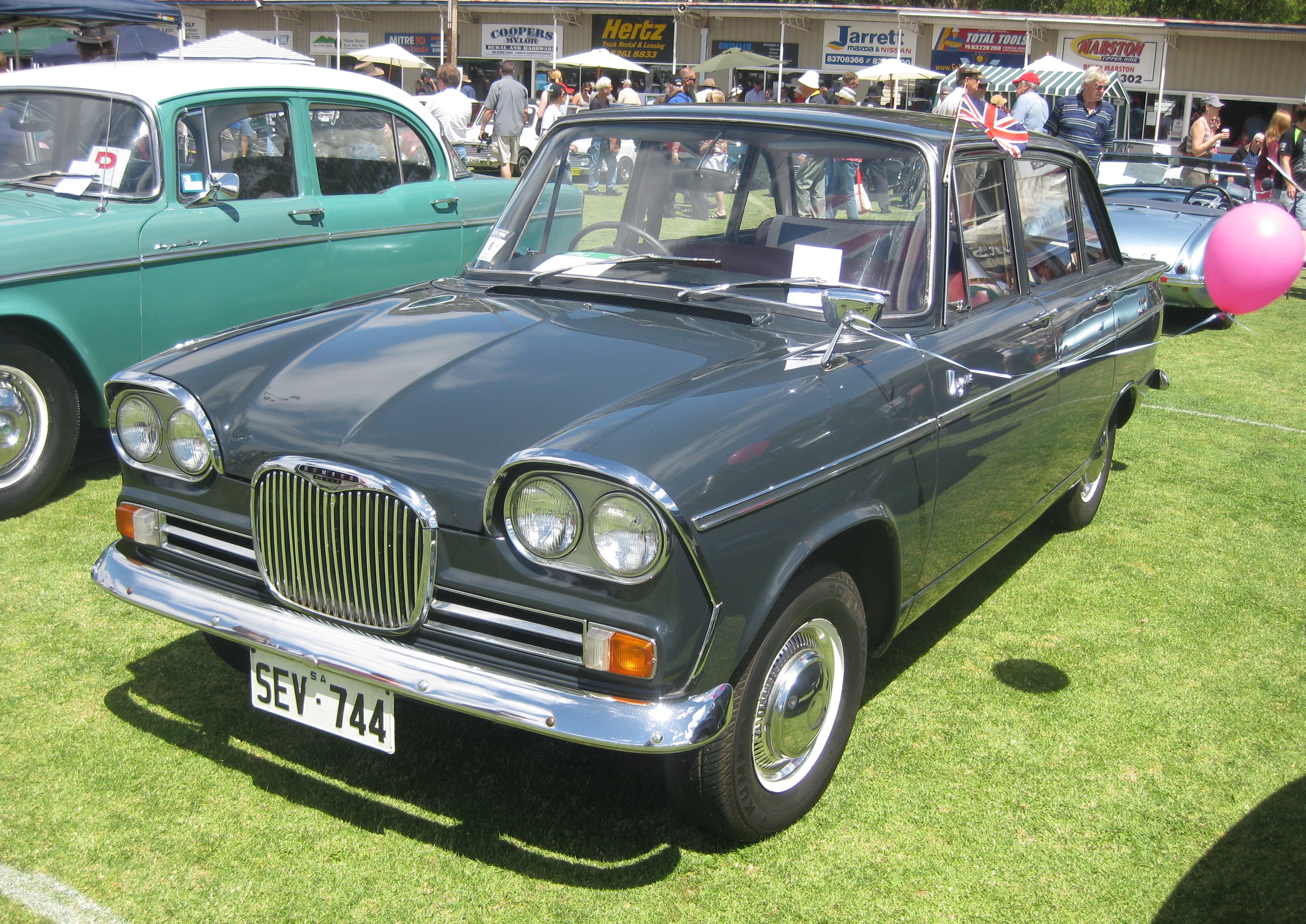Singer Vogue on:
[Wikipedia]
[Google]
[Amazon]
The Singer Vogue name has been applied to two generations of
 The first generation Singer Vogue I/II/III/IV models of 1961 to 1966, was a
The first generation Singer Vogue I/II/III/IV models of 1961 to 1966, was a
Vogue MkI.JPG, Singer Vogue Series I, with chrome bonnet strip and white indicators
Singer Vogue Mk IV 1966 (14375162784).jpg, Singer Vogue Series IV saloon
1965 Singer Vogue Estate.jpg, Singer Vogue Estate of 1965
 The Vogue was also produced in
The Vogue was also produced in
Retrieved on 7 August 2013 It was introduced in 1963 and was followed by the Vogue Sports which was fitted with a
Retrieved via web.archive.org on 7 August 2013 This Series III version featured a squared roofline as introduced on the Singer Vogue III in 1964. Australian production of the Vogue ceased in 1966 following the takeover of Rootes Australia by
Retrieved on 20 June 2014 In New Zealand, Todd Motors produced a Singer Vogue as an up-market version of the Hunter. Prime differences were its wooden dashboard and door cappings. Along with all other Singer models, the Vogue was discontinued in 1970 to be replaced by the short lived Sunbeam Vogue.
1969 Singer Vogue 1725 CC (18775219902).jpg, 1969 Singer Vogue saloon
1968 Singer Vogue Estate 1.8.jpg, 1968 Singer Vogue Estate
motor cars
An engine or motor is a machine designed to convert one or more forms of energy into mechanical energy.
Available energy sources include potential energy (e.g. energy of the Earth's gravitational field as exploited in hydroelectric power gene ...
from the British manufacturer Singer
Singing is the art of creating music with the voice. It is the oldest form of musical expression, and the human voice can be considered the first musical instrument. The definition of singing varies across sources. Some sources define singi ...
.
Vogue Series I/II/III/IV
badge engineered
In the automotive industry, rebadging (also known as badge engineering, an intentionally ironic misnomer in that little or no actual engineering takes place) is a form of market segmentation used by automobile manufacturers around the world. T ...
version of the Hillman Super Minx. Introduced in July 1961, it was positioned above the Super Minx and Singer Gazelle
The Singer Gazelle name has been applied to two generations of motor cars from the British manufacturer Singer. It was positioned between the basic Hillman range and the more sporting Sunbeam versions.
Gazelle I and II
The Gazelle was the f ...
in the Rootes Group
The Rootes Group was a British automobile manufacturer and, separately, a major motor distributors and dealers business. From headquarters in the West End of London, the manufacturer was based in the English Midlands, Midlands and the distribu ...
range, and had twin headlights as well as a more powerful version of the Minx engine. The Series II version for 1963 had front disc brakes
Disc or disk may refer to:
* Disk (mathematics), a two dimensional shape, the interior of a circle
* Disk storage
* Optical disc
* Floppy disk
Music
* Disc (band), an American experimental music band
* ''Disk'' (album), a 1995 EP by Moby
Other ...
as standard, changes to the interior, removal of the chrome bonnet strip and a change to amber front indicator lenses. The Series III of 1964 gained six light bodywork and an increase in power to . The final version of this generation, the Series IV was introduced at the 1965 motor show and saw the engine size increased to although there was no change in power output. The first generation Vogue was offered as a four door saloon and as an estate car
A station wagon ( US, also wagon) or estate car ( UK, also estate) is an automotive body-style variant of a sedan with its roof extended rearward over a shared passenger/cargo volume with access at the back via a third or fifth door (the lift ...
.
Australian production as the Humber Vogue
 The Vogue was also produced in
The Vogue was also produced in Australia
Australia, officially the Commonwealth of Australia, is a country comprising mainland Australia, the mainland of the Australia (continent), Australian continent, the island of Tasmania and list of islands of Australia, numerous smaller isl ...
, by Rootes Australia
Rootes Australia was the Australian affiliate of the Rootes Group, a British motor vehicle manufacturing company.The Macquarie Dictionary of Motoring, 1986, page 413
The company was formed immediately after the Second World War initially operati ...
, and was marketed as the Humber Vogue.Joe Kenwright, Aussie Original: Humber Vogue, www.uniquecarsmag.com.auRetrieved on 7 August 2013 It was introduced in 1963 and was followed by the Vogue Sports which was fitted with a
Sunbeam Rapier
The Sunbeam Rapier is an automobile produced by Rootes Group from 1955 until 1976, in two different generations, the "Series" cars (which underwent several revisions) and the later (1967–76) fastback shape, part of the "Rootes Arrow, Arrow" ran ...
engine that provided a 35 per cent increase in power to . The Vogue Sports also featured improved suspension, brakes and wheels. The Rapier-powered Vogue III was introduced in early 1965 at which time the Vogue Sports was discontinued.Australian History, Humber Enthusiasts Group Of NSWRetrieved via web.archive.org on 7 August 2013 This Series III version featured a squared roofline as introduced on the Singer Vogue III in 1964. Australian production of the Vogue ceased in 1966 following the takeover of Rootes Australia by
Chrysler Australia
Stellantis (Australia and New Zealand) Pty Ltd (formerly FCA Australia), is the official Stellantis subsidiary in Australia and New Zealand, operating as distributor of Chrysler, Jeep, Dodge, Abarth, Alfa Romeo, Fiat and Leapmotor vehicles. Ho ...
.
New Vogue
The second generation Singer New Vogue launched at the 1966British International Motor Show
The British International Motor Show was an annual (bi-biennial after 1976) motor show held by the Society of Motor Manufacturers and Traders (SMMT) between 1903 and 2008 in England. The show was relaunched in 2021 with a new location at Farnb ...
, was a badge engineered version of the Rootes Arrow
Rootes Arrow was the manufacturer's name for a range of automobile, cars produced under several badge engineering, badge-engineered marques by the Rootes Group (later Chrysler Europe) from 1966 to 1979 in Europe, and continuing on until 2005 in I ...
saloon. More upmarket than the Hillman Hunter
Hunting is the human practice of seeking, pursuing, capturing, and killing wildlife or feral animals. The most common reasons for humans to hunt are to obtain the animal's body for meat and useful animal products ( fur/ hide, bone/tusks, ...
, it was powered by the same engine and was the first British car to feature rectangular headlamps. An estate version was released in April 1967.The Vogue Story, www.asco.org.ukRetrieved on 20 June 2014 In New Zealand, Todd Motors produced a Singer Vogue as an up-market version of the Hunter. Prime differences were its wooden dashboard and door cappings. Along with all other Singer models, the Vogue was discontinued in 1970 to be replaced by the short lived Sunbeam Vogue.
Scale models
*MeccanoDinky Toys
Dinky Toys was the brand name for a range of die-cast zamak zinc alloy scale model vehicles, traffic lights, and road signs produced by British toy company Meccano Ltd. They were made in England from 1934 to 1979, at a factory in Binns Road in ...
; No. 145 (production 1962–66), Series 1 Vogue, approximately O scale (1:44).
References
{{Commons categoryVogue
Vogue may refer to:
Business
* ''Vogue'' (magazine), a US fashion magazine
** British ''Vogue'', a British fashion magazine
** '' Vogue Adria'', a fashion magazine for former Yugoslav countries
** ''Vogue Arabia'', an Arab fashion magazine
** ' ...
Cars introduced in 1961
1970s cars
Rear-wheel-drive vehicles
Sedans
Station wagons